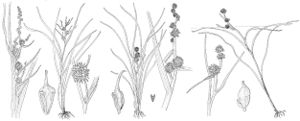Sparganium
Sp. Pl. 2: 971. 1753; Gen. Pl. ed. 5; 418, 1754.
| Taxon | Illustrator ⠉ | |
|---|---|---|
 | Sparganium emersum Sparganium eurycarpum Sparganium natans | John Myers John Myers John Myers |
Herbs, erect or floating, or sometimes with some leaves floating and some emergent. Leaves flat, planoconvex, or abaxially keeled and V-shaped in section, spongy, margins entire. Flowers wind-pollinated, odorless, sessile. Fruits sessile or stipitate; tepals persistent, attached at base, in one species partially adnate to stipe. Seeds 1–2 (–3), slender-ovoid; coat thin, appressed to endocarp. x = 15.
Distribution
Mostly N tempnorth temperate, some circumboreal, North America, a few s to Mexico, e Asia, Pacific Islands (New Zealand), and Australia
Discussion
The plants flower in late spring to late summer, and the flowering season is shorter northward and at higher elevations. Fruiting is in late summer and fall, and some plants flower and fruit simultaneously in late season, especially northward and at higher elevations. Occasional plants have only staminate flowers.
Mature fruits are needed for identification of some species. The tepals, style, and often the stigmas remain attached to the mature fruits; the persistent style and stigma formis the beak. The staminate rachises often persist, and the location and numbers of staminate heads can be determined from the scars of the fallen heads, even in fruiting specimens.
Some species show great variation, and specimens can be difficult to assign. Most characteristics depart at least occasionally from those given in the key, and foliar cross sectional details are often distorted in dried specimens. In some erect species growing partially submersed, the first leaves of the season are submersed or floating and limp, and later leaves are emergent and stiffer. In species with normally erect leaves, deep or moving waters often suppress flowering and stimulate formation of only long, ribbonl-like leaves that resemble those of species that produce only floating leaves. Species normally having floating leaves sometimes produce partially erect leaves when stranded. Depauperate or deep-water individuals of species that usually bear branched rachises sometimes have simple rachises with shortened internodes, and then the flowers and fruits are often reduced in number, but their morphology is little affected.
Many hybrids are reported in Sparganium, and they are discussed at length in a monograph (by C. D. K. Cook and M. S. Nicholls (1986, 1987), but few are verified. For detailed discussion of the complex nature of the inflorescences, see U. Müller-Doblies (1969) and D. Müller-Doblies (1970); for extensive bibliographies, see C. D. K. Cook and M. S. Nicholls, (1986, 1987) and J. W. Thieret (1982); and for information about water quality and substrate preferences of the species, see E. O. Beal (1977), T. C. Brayshaw (1985), C. D. K. Cook and M. S. Nicholls (1986, 1987), and G. E. Crow and C. B. Hellquist (1981).
The worldwide monograph of Sparganium (by C. D. K. Cook and M. S. Nicholls (1986, 1987) is the most comprehensive treatment; most of their nomenclature is used herein. Nevertheless, the taxonomy must be regarded as tentative in the absence of detailed studies of any species over its full range. Phenotypic, ecotypic, and clinal variation are great in most species, the influence of hybridization is unclear, and some species are but dubiously differentiated from their Eurasian vicariants.
Collecting of Sparganium has been uneven in Alaska, Greenland, and northern Canada. The ranges there probably exceed those shown on the distribution maps.
Species 14 (9 in the flora).
Selected References
None.
Lower Taxa
Key
| 1 | Stigmas 2 on all or many pistillate flowers, 1 on others; fruits sessile, obpyramidal, depressed-truncate to somewhat rounded or tapering distally, not constricted at equator, body faceted; leaves erect, emergent. | Sparganium eurycarpum |
| 1 | Stigma 1; fruits fusiform, ellipsoid, or obovoid, tapering at tip to beak (or beakless) and often to stipe below, usually constricted near equator; sides not or only weakly faceted; leaves erect and emergent or limp and floating. | > 2 |
| 2 | Leaves and inflorescence emergent, erect, stiff; leaves keeled throughout or at least toward base. | > 3 |
| 2 | Leaves and inflorescence floating, limp; leaves flat or plano-convex, unkeeled or keeled only near base. | > 6 |
| 3 | Inflorescence rachis branched. | > 4 |
| 3 | Inflorescence rachis unbranched. | > 5 |
| 4 | Rachis branches, or at least some, with 1–3 pistillate heads; fruiting heads 1.5–2.5 cm diam.; fruits dull; bracts somewhat ascending | Sparganium americanum |
| 4 | Rachis branches without pistillate heads, rarely with 1; fruiting heads 2.5–3.5 cm diam; fruits distally shiny, proximally dull; bracts strongly ascending. | Sparganium androcladum |
| 5 | Staminate heads 1(–2); fruiting heads 1.2–1.6(–2) cm diam.; fruit beak 1.5–2 mm. | Sparganium glomeratum |
| 5 | Staminate heads 3–7(–10); fruiting heads 1.6–3.5 cm diam.; fruit beak 2–4.5 mm. | Sparganium emersum |
| 6 | Staminate heads 1(–2); inflorescence rachis unbranched. | > 7 |
| 6 | Staminate heads 2 or more; inflorescence rachis branched or not. | > 8 |
| 7 | Pistillate heads axillary and sessile or proximal head axillary and peduncled; fruit beak 0.5–1.5 mm. | Sparganium natans |
| 7 | Pistillate heads, at least one of them, supra-axillary and peduncled; fruit beak less than 0.5 mm, or absent | Sparganium hyperboreum |
| 8 | Rachis usually branched; tepals borne at middle of fruit stipe | Sparganium fluctuans |
| 8 | Rachis unbranched; tepals borne at or near base of fruit stipe. | > 9 |
| 9 | Staminate heads, or some of them, not contiguous; fruit beak 2–4.5 mm; leaves keeled toward base. | Sparganium emersum |
| 9 | Staminate heads contiguous, appearing as single elongate head; fruit beak 1.5–2 mm; leaves unkeeled. | Sparganium angustifolium |
"elongating" is not a number.